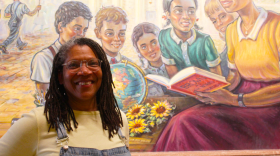-
Artist Luis Quintanilla fled the Spanish Civil War to escape persecution, but most of his work was destroyed. Today, one of his two remaining murals sits in an otherwise ordinary corner of the University of Missouri-Kansas City. Newly restored, Quintanilla’s bizarre and enthralling masterpiece stands as a testament to immigrants and the danger of authoritarianism.
-
The Mizzou Tigers and the Kansas Jayhawks are set to take the field on Saturday for the first time since 2011.
-
Once strong and thriving, Clayton’s Black community was wiped out by urban renewal policies that drove out several hundred residents during the 1950s and '60s. Now the city's downtown business district stands in its place.
-
Kansas City’s central location and easy access to rail travel, along with Missouri’s simplified adoption laws favoring secrecy, attracted prospective parents from around the U.S. Over the first part of the 20th century, more than a dozen homes for unwed mothers flourished, the largest and most well-known of which was The Willows.
-
Lead plaintiff Oliver Brown's name rings loudest from the 1954 Brown v. Board desegregation case, but 12 women fought alongside him in Topeka. Kansas Historical Society curator Donna Rae Pearson's "Women of Brown" exhibit helps tell their story.
-
The landmark 1954 U.S. Supreme Court ruling that outlawed racial segregation in public schools may have played out differently if it hadn’t been for a tenacious group of women in Johnson County, Kansas, who led their own integration lawsuit five years earlier. The case centered around a two-room schoolhouse and included a lengthy boycott, big-shot NAACP lawyers, FBI surveillance — and six very brave children.
-
Lawrin was owned by Herbert Woolf, the president of Woolf Brothers, one of the most important clothing stores in Kansas City history. Woolf also had an odd connection to political boss Tom Pendergast.
-
Kansas City native Edward J. Dwight Jr. is set to be on the next Blue Origin rocket into space. The rare opportunity comes more than six decades after he was passed over to become a NASA astronaut.
-
Business owners have campaigned for nearly two years to sever Troost Avenue from its slaveholding past. But the effort has hit a bureaucratic roadblock, as Mayor Quinton Lucas tries to avoid another public controversy like the failed renaming of The Paseo.
-
Once seen as a musical relic, audio cassettes have survived the eras of CDs and streaming to win over music lovers of a new generation. That’s in large part thanks to the National Audio Company in Springfield, Missouri, the largest cassette manufacturer in the world.
-
Would the Chiefs and Royals really leave Kansas City if the sales tax vote fails? History says maybeRepresentatives of the Chiefs and Royals have suggested they would consider other “options” if Jackson County voters don't approve a sales tax to help fund a downtown ballpark and upgrade Arrowhead. It's not inconceivable that a professional sports team would leave Kansas City — because it's happened before.
-
If Jackson County voters feel conflicted about the April 2 stadium sales tax vote to help finance a new downtown ballpark for the Royals and Arrowhead Stadium improvements for the Chiefs, they can be confident in this: political fights over stadiums is a local tradition that goes back at least 93 years.
-
Missouri, which earned the infamous nickname of "meth capital of America," played a key role in the drug's spread across the country. A new podcast tells that story.
-
Up until a few weeks ago, Lynette Woodard from the University of Kansas had scored more points in college basketball than any woman ever. But she was never recognized by the NCAA as a scoring champion.
-
The state of Missouri is celebrating its 200th birthday. But few people today know about the Missouria, the Native American tribe behind the state’s name.
-
Each state gets to honor two citizens with statues in the U.S. Capitol in Washington, D.C. In 2022, one of Missouri's contributions will be a statue of President Harry S. Truman.
-
In the turbulent years following the Civil War, around 27,000 former slaves migrated to Kansas. They called themselves "exodusters" and they were fleeing Jim Crow laws. Some of them are remembered in a portrait exhibition of an African-American community in Leavenworth, Kansas.
-
Stories of the most famous African Americans from Kansas City are well told, but the work of many more community members often goes unrecognized.
-
Kamala Harris is set to become the country’s first female vice president. Harris is a Black woman of Indian and Jamaican descent, and the occasion is inspiring people of color across Kansas City.
-
Disease and conflict shadowed frontier life during the heydey of many historic homes in the metro. Visitors have a chance to view today's events through the lens of history at places like the John Wornall House and the Mahaffie Stagecoach Stop and Farm.
-
A nearly two-year renovation project on the former Rockhill Tennis Club is coming to a close. And the owners are asking for a significant boost from the purchase price.
-
A reckoning is taking place in Kansas City when it comes to buildings, fountains, street names, and monuments — and uncovering layers of history.
-
Three professors from Haskell Indian Nations University discuss the mutual support — and historical connection — between their communities and the Black Lives Matter movement.
-
Perspective: Will the events of 2020 force Kansas City to reckon with the opposing forces that have defined us from the beginning?



























